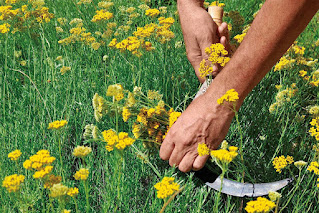Greeting of "Jāņi children" by the house owners during Jāņi (Yanee) day, Latvian summer solstice festival. Pic: Leonid Vladimirovic.
There is something strange about this Latvian holiday. It has part of what we find in Slavic mid summer rituals and part of what we find in Slavic beginning of summer rituals all mixed in one...
For instance, Gathering the fern flower ritual is in Slavic countries performed during mid summer Ivan dan (Jāņi dan) celebrations, just like in Latvia.
Bonfire lighting which is done in Latvia on the eve of the Jāņi day, is another ritual which is in Slavic countries done on Ivan dan. Pic: Jāņi bonfire
While in Slavic (Balkan) countries this is done at the beginning of the summer, in late April, early May...I talked about this in my post "Flower girls"...
And particularly interesting is the belief in Latvia that "medicinal herbs picked on Jāņi day have special powers and are particularly potent". In Slavic (Balkan) countries the belief is that the "medicinal herbs picked at the beginning of the summer have special powers are are particularly potent". Which is when medicinal herbs are gathered...I talked about this in my post "Herb Friday"...
Finally, Latvian belief that"girls should, on Jāņi day, wash their faces with the morning dew, so their face will always be white and beautiful" is in Slavic (Balkan) cultures and in Celtic (Gaelic) cultures is done at the beginning of summer. I talked about this in my post "Morning dew"...
I wonder if this is an example of customs and rituals, which as they moved up north, to the colder parts of Europe, were moved from the beginning of summer to the middle of summer, to fit with the local climate (medicinal herbs flowering later and dew appearing later)...
The reason why I believe flower wreath, medicinal herbs and morning dew rituals didn't originate in Latvia, and were originally performed at the beginning of summer, is because both the Irish and Serbian traditions agree when dew face wash should be done (beginning of summer)
As we know the Irish and the Serbs didn't really have much cultural contacts in say, few thousand years...🙂 So we could be pretty sure that this is an ancient custom preserved by both people independently, and not borrowed from each other recently...
Anyway, very interesting I think and worth further research...





This looks like San Xoan in Galiza: same date, same bonfires, herbs are recollected and bottled with water to wash face etc. Main difference is that flowers are used in the First of May or in local holidays in the beginning of summer
ReplyDeleteAnother possibility: the custom originated in Latvia, changed dates when it went south, and the dates that arrived in Ireland are the southern ones (not the older Latvian ones)
ReplyDeleteI sincerely doubt this...Latvia was heavily influenced culturally by the Slavs, whereas the influence going the other way round is, as far as I know, non existent...I don't even want to talk about the Irish...
Delete